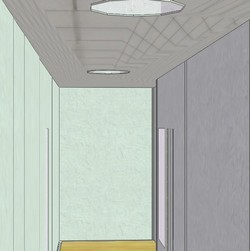

Housing Project
Dee Park
- Location:
- Reading
- Client:
- Catalyst Housing Group
- Architect:
- Hta
- Contractor:
- Willmott Dixon Housing Limited
- Cost:
- £9,000,000
Dee Park Extra Care Home
Dee Park, site 6A is a 60-unit "extra care" home for the elderly, which is part of a large regeneration development. As well as the residential units, there are on-site communal facilities, such as a large dining room, commercial kitchen, and a hairdressing salon.
Overheating Assessment
To assess possible overheating during the summer months, a 3D model of the building was constructed using dynamic simulation software. The model was rendered in detail, and thorough calculations were performed to analyse internal temperatures arising through various heat gains, looking throughout the year, at hourly intervals. All bedroom and living room temperatures were assessed against criteria put forward by CIBSE. Internal corridors were also assessed, but without specific criteria, the aim being to keep the temperatures as low as possible using only natural ventilation.
Mitigating Overheating
The level of detail in the model allowed the possibility of introducing various methods of minimising temperatures within the key areas of the building. Restricted levels of window opening could be accurately reflected and applied to the living rooms and bedrooms. Within the corridors, which contain the bulk of the heating and hot water pipework, high specification insulation was considered to reduce the heat emitted. Efficient lighting with minimal heat output was also important within these spaces. The model also allowed for a thorough airflow analysis, which considered the effects of adjoining corridor doors being held open, as well as the innovative manual override of the AOVs to introduce a "stack effect" within the central corridor spaces.
Final Scheme
As well as for the thermal assessment, the model was important in establishing a BREEAM "Excellent" rating. In addition, the rating was achieved by utilising ultra-low NOx boilers and water generators, low water consumption sanitary appliances, and PV panels on the roof. The scheme, now known as "Oak Tree House", was officially opened by HRH the Duke of Kent